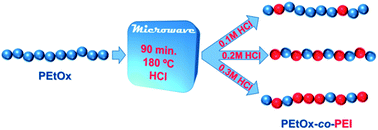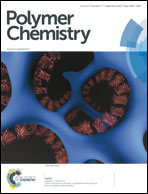Fast and accurate partial hydrolysis of poly(2-ethyl-2-oxazoline) into tailored linear polyethylenimine copolymers†
Abstract
Partial hydrolysis of poly(2-oxazoline)s yields poly[(2-oxazoline)-co-(ethylenimine)] copolymers that are of interest for a broad range of applications, from switchable surfaces, nanoparticles and hydrogels, to gene delivery and biosensors. In the present research, a fast and reproducible method is developed to obtain poly[(2-ethyl-2-oxazoline)-co-(ethylenimine)] (P(EtOx-co-EI)) copolymers via acid-catalyzed partial hydrolysis of poly(2-ethyl-2-oxazoline) (PEtOx). The hydrolysis kinetics were investigated by 1H-NMR spectroscopy and size exclusion chromatography using hexafluoroisopropanol as eluent. It was found that the hydrolysis was greatly accelerated by increasing the temperature from 100 °C up to near-critical water (275 °C) using microwave reactors; similar results were obtained in conventional pressure reactors at 180 °C. The optimal hydrolysis with regard to speed and control over the final copolymer structure was achieved at 180 °C, since the polymer was found to degrade and decompose above this temperature. In addition, control over the desired degree of hydrolysis of PEtOx was obtained by selecting the appropriate HCl concentration. To summarize, this work reports on defining optimal conditions to achieve tailored P(EtOx-co-EI) copolymers in a fast and reproducible way, utilizing high temperatures and controlled acidic conditions.


 Please wait while we load your content...
Please wait while we load your content...